engine GMC JIMMY 1997 User Guide
[x] Cancel search | Manufacturer: GMC, Model Year: 1997, Model line: JIMMY, Model: GMC JIMMY 1997Pages: 410, PDF Size: 20.03 MB
Page 83 of 410
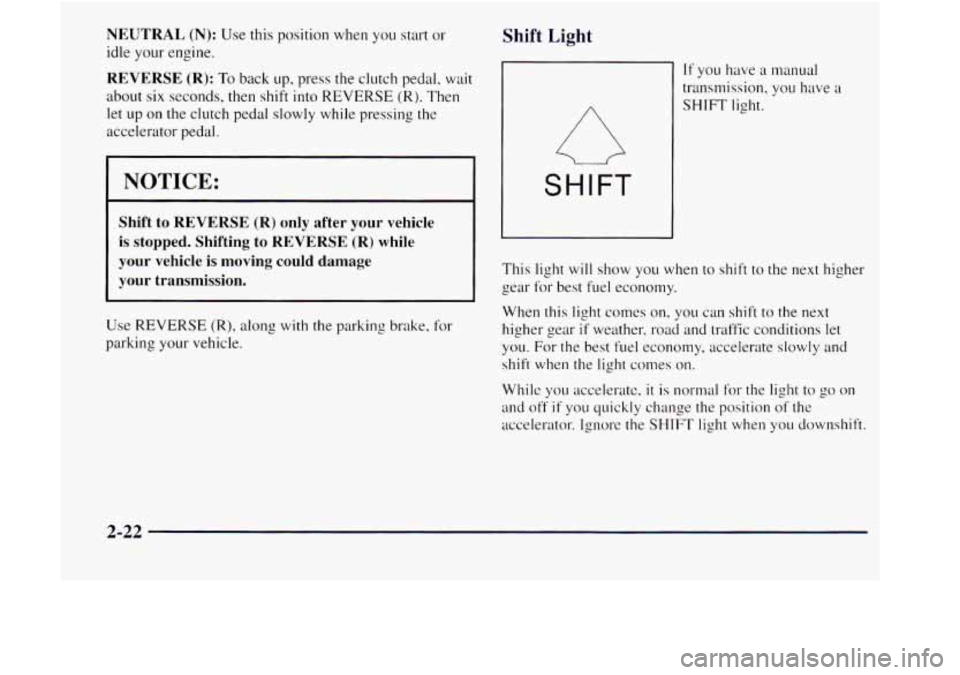
NEUTRAL (N): Use this position when you start or
idle your engine.
REVERSE (R): To back up, press the clutch pedal, wait
about six seconds, then shift into
REVERSE (R). Then
let
up on the clutch pedal slowly while pressing the
accelerator pedal.
I NOTICE:
Shift to REVERSE (R) only after your vehicle
is stopped. Shifting to REVERSE
(R) while
your vehicle
is moving could damage
your transmission.
Use REVERSE (R), along with the parking brake. for
parking your vehicle.
Shift Light
SHIFT
If you have a manual
transmission. you have a
SHIFT light.
This light
will show you when to shift to the next higher
gear for best fuel economy.
When this
light comes on, you can shift to the next
higher gear
if weather, road and traffic conditions let
you. For the best fuel economy, accelerate slowly
and
shift when the light comes on.
While you accelerate, it is normal for the light to go on
and off if you quickly change the position of the
accelerator. Ignore the
SHIFT light when you downshift.
2-22
Page 84 of 410
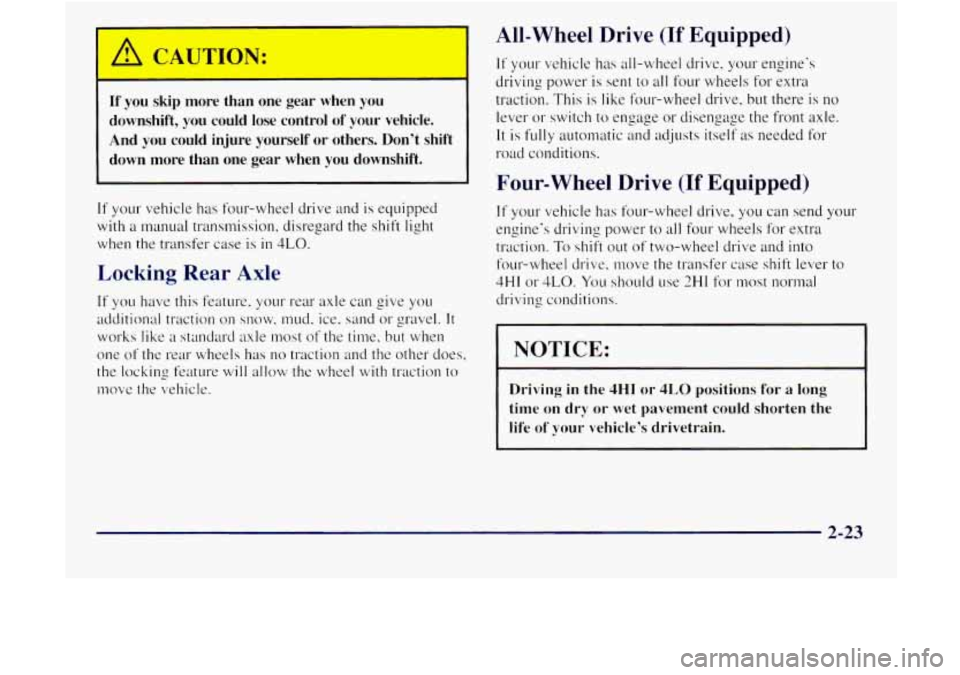
If’ you skip more than one gear when you
downshift, you could lose control
of your vehicle.
And you could injure yourself or others. Don’t shift
down more than one gear when
you downshift.
If your vehicle has four-wheel drive and is equipped
with a manual transmission. disregard the shift light
wlxn the transfer case is in 4LO.
Locking Rear Axle
If you have this feature. your rear axle can give you
additional traction
on sno\v, mud. ice, sand 01- gra~~l. It
works like a standard axle most of the time, but when
one of the rear nhxls has
no traction and the other does,
the locking feature
will allow the wheel with traction to
~nove the vehicle.
All-Wheel Drive (If Equipped)
If your \:chicle has all-wheel drive, your engine’s
driving power is sent to all four wheels for extra
traction. This is like four-wheel drive, but there is
no
lever or switch to engage or disengage the front axle.
It is fully automatic and adjwts itself as needed for
mid conditions.
Four-wheel Drive (If Equipped)
If your vehicle has four-wheel drive, you can send your
engine’s driving power
to all four wheels for extra
traction.
To shift out of two-wheel drive and into
four-wheel drive, move the transfer case shift lever to
4HI or 4LO. You should use ?HI for most normal
driving conditions.
1 NOTICE:
~~ ~~~~~ ~~ ~~~~
Driving in the 4HI or 41,O positions for a long
time on
dry or wet pavement could shorten the
life of your vehicle’s drivetrain.
2-23
Page 91 of 410

Shifting Into PARK (P) (Automatic
Transmission
Models Only)
It can be dangerous to get out of your vehicle if
the shift lever
is not fully in PARK (P) with the
parking brake firmly set. Your vehicle can roll.
If you have left the engine running, the vehicle can
move suddenly. You or others could be injured.
To be sure your vehicle won’t move, even when
you’re on fairly level ground, use the steps that
follow. If you have four-wheel drive with a manual
transfer case shift
lever and your transfer case is
in NEUTRAL (N), your vehicle will be free to roll,
even if your shift lever is in PARK (P). So, be sure
the transfer case is in
a drive gear -- not in
NEUTRAL
(N). If you’re pulling a trailer, see
“Towing a Trailer” in the Index.
Column Shift Lever
1. Hold the brake pedal down with your right foot and
set the parking brakc.
2. Move the shift lever into PARK (P) position like this:
2-30
Page 93 of 410

Leaving Your Vehicle With the Engine
Running (Automatic Transmission
Models Only)
It can be dangerous to leave your vehicle with the
engine running. Your vehicle could move suddenlJ
if the shift lever
is not fully in PARK (P) with the
parking brake firmly set. If you have four-wheel
drive with
a manual transfer case shift lever and
your transfer case
is in NEUTRAL (N), your
vehicle will
be free to roll, even if your shift lever
is in
PARK (P). So be sure the transfer case is in a
drive gear
-- not in NEUTRAL (N). And, if you
leave the vehicle with the engine running, it could
overheat and even catch fire. You or others could
be injured. Don't leave
your vehicle with the
engine running unless you have to.
If you have to leave your vehicle with the engine
running, be sure your vehicle
is in PARK (P) and yo~~r parking brake
is firmly set before you leave
it. After
you've moved the shift lever into the PARK
(P)
position, hold the regular brake pedal down. Then, see
if you can move the shift lever away from PARK (P)
without first pulling it toward you (or pressing the
button on
a console shift lever). If YOLI can, it means that
the shift lever wasn't fully locked
into PARK (P).
Torque Lock (Automatic Transmission)
If you are parking on a hill and you don't shift your
transmission into PARK
(P) properly, the weight of the
vehicle may put too much force
on the parking pawl in the
transmission. You may find it difficult to pull the shift
lever out
of PARK (P). This is called "torque lock." To
prevent torque lock, set the parking br'ke and then shift
into PARK
(P) properly before you leave the driver's seat.
To find out how, see "Shifting Into PARK (P)" in
the Index.
When
you are ready to drive, move the shift lever out of
PARK (P) kc$~w you release the parking brake.
IF torque lock does occur. you may need to have another
vehicle push yours
a little uphill to take some of the
pressure from
the parking pawl in the transmission, so
~OLI can pull the shift lever out of PARK (P).
2-32
Page 94 of 410

Shifting Out of PARK (P)
(Automatic Transmission)
Your vehicle has a brake-transmission shift interlock.
YOLI have to fully apply your regular brake before you
can shift
from PARK (PI when the ignition is in the
RUN position. See "Automatic Transmission Operation"
in the Index.
If you cannot shift out of PARK (P)? ease pressure on
the shift lever
-- push the shift lever all the way into
PARK (P) as you maintain brake application. Then
move the shift lever into the gear you want (you must
press the shift lever button
if you have the console
shift lever).
If you ever hold the brake pedal down but still can't
shift out
of PARK (P)? try this:
1. Turn the key to OFF.
2. Apply and hold the brake until the end of Step 3.
3. Shift to NEUTRAL (N).
4. Start the vehicle and then shift to the drive gear
you want.
5. Have the vehicle fixed as soon as you can.
Parking Your Vehicle (Manual
Transmission Models Only)
Before you get out of your vehicle, turn off your engine,
put your- manual transmission in REVERSE (R) and
firmly apply the parking brake.
If you have four-wheel drive with it manual transfer case
shift lever, be sure your transfer case is in a drive gear.
Your vehicle could roll
if it isn't.
If you are parking on a hill. or if your vehicle is pulling
a trailer, see "Towing a Trailer" in the Index.
2-33
Page 95 of 410

Parking Over Things That Burn Engine Exhaust
I,
Things that can burn could touch hot exhaust
parts under your vehicle and ignite. Don’t park
over papers, leaves, dry grass or other things that
can burn.
J
‘
h CAUTION:
Engine exhaust can kill. It contains the gas
carbon monoxide
(CO), which you can’t see or
smell. It can cause unconsciousness and death.
You might have exhaust coming
in if:
Your exhaust system sounds strange
Your vehicle gets rusty underneath.
Your vehicle was damaged in a collision.
Your vehicle was damaged when driving
over high points on the road or over
road debris. or
different.
Repairs weren’t done correctly.
0 Your vehicle or exhaust system had been
modified improperly.
If you ever suspect exhaust is coming into
your vehicle:
0 Drive it only with all the windows down to
0 Have your vehicle fixed immediately.
blow
out any
CO; and
2-34
Page 96 of 410

Running Your Engine While You’re
Parked (Automatic Transmission)
It’s better not to park with the engine running. But if
ever have to, here are some things to know.
Idling the engine with the air system control
off could allow dangerous exhaust into
your vehicle (see the earlier Caution under
“Engine Exhaust”).
Also, idling in a closed-in place can let deadly
carbon monoxide
(CO) into your vehicle even if
the fan switch is at the highest setting. One place
this can happen is a garage. Exhaust
-- with
CO -- can come in easily. NEVER park in a
garage with the engine running.
Another closed-in place can be
a blizzard.
l (See “Blizzard” in the Index.)
I-
It can be dangerous to get out of your vehicle if
the shift lever is not fully in
PARK (P) with the
parking brake firmly set. Your vehicle can roll.
Don’t leave your vehicle when the engine is running unless you have to.
If you’ve left the
engine running, the vehicle can move suddenly.
You or others could be injured.
To be sure your
vehicle won’t move, even when you’re on fairly
level ground, always set your parking brake and
move the shift lever to
PARK (P).
If you have four-wheel drive with a manual transfer case
shift lever and your transfer case is in NEUTRAL
(N),
your vehicle will be free to roll, even if your shift lever
is in
PARK (P). So, be sure the transfer case is in a drive
gear
-- not in NEUTRAL (N). Always set your parking
brake. Follow the proper steps
to be sure your vehicle
won’t move. See “Shifting Into
PARK (P)” in the Index.
If you’re pulling a trailer, see “Towing a Trailer” in
the Index.
2-35
Page 126 of 410
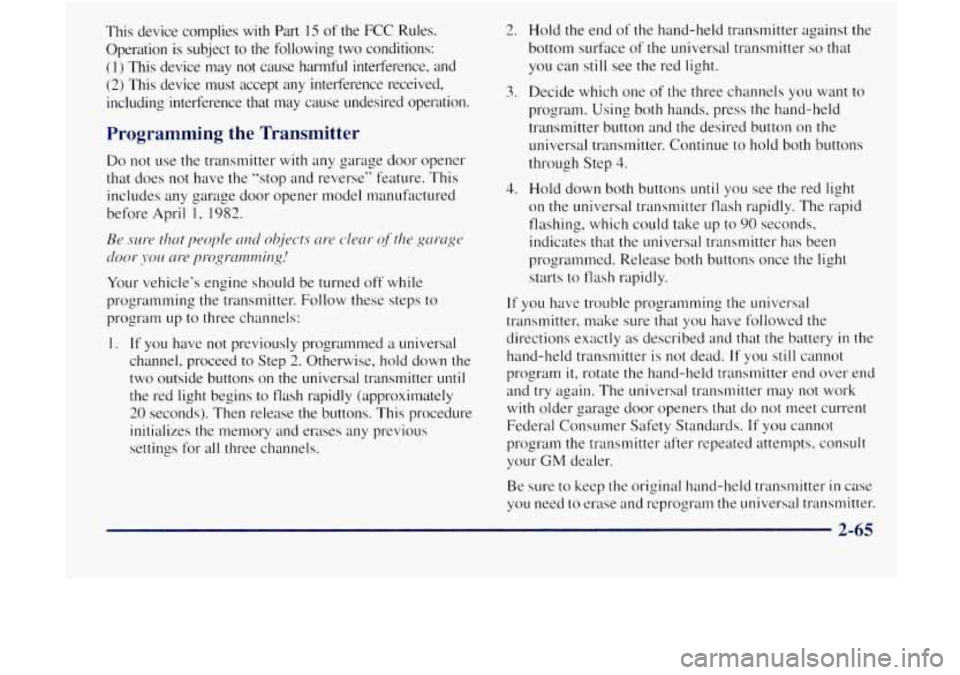
This device complies with Part 15 of the FCC Rules.
Operation is subject to the following two conditions:
( I ) This device may not cause harmful interference, and
(2) This device must accept any interference received,
including interference that may cause undesired operation.
Programming the Transmitter
Do not LIS~ the transmitter with any garage door opener
that does not have the ”stop and reverse’‘ feature. This
includes any garage door opener model manufactured
before April
1, 1982.
Re .WI-P tllcrt pwplt~ cml ohjucts c11-0 clmr of‘the g(it-cqe
cloo~. Jolr citxl I?t-~.’s”L“ll}”ill,s!
Your vehicle’s engine should be turned off while
programming the transmitter. Follow these steps to
program
up to three channels:
I, If you have not previously programmed a universal
channel, proceed to Step
2. Otherwise, hold down the
two outside buttons on the universal transmitter
until
the red light begins to flash rapidly (approximately
20 seconds). Then rekase the buttons. This procedure
initializes the memory and erases any previous
settings for all three channels.
2. Hold the end of the hand-held transmitter against the
bottom surface of the ~~niversal transmitter
so that
you can still see the red
light.
3. Decide which one of the three channels you want to
program. Using both hands, press the hand-held
transmitter button and the desired button on the
universal transmitter. Continue
to hold both buttons
through Step
4.
4.
Hold down both buttons until yo~r see the red light
on the Llniversal transmitter flash rapidly. The rapid
flashing, which could take up
to 90 seconds,
indicates that the universal transmitter has been
programmed. Release both buttons once the light
starts
to flash rapidly.
If you have trouble programming the universal
transmitter, make s~rre that you have followed the
directions exactly
as described and that the battery in the
hand-held transmitter is not dead.
If yo~t still cannot
program
it, rotate the hand-held transmitter end over end
and
try again. The universal transmitter may not work
with older garage door openers that do not meet current
Federal Consumer Safety Standards.
If you cannot
program the transmitter after repeated attempts. consult
your
GM dealer.
Be sure to keep the original hand-held transmitter in case
you need
to erase and reprogram the universal transmitter.
2-65
Page 130 of 410
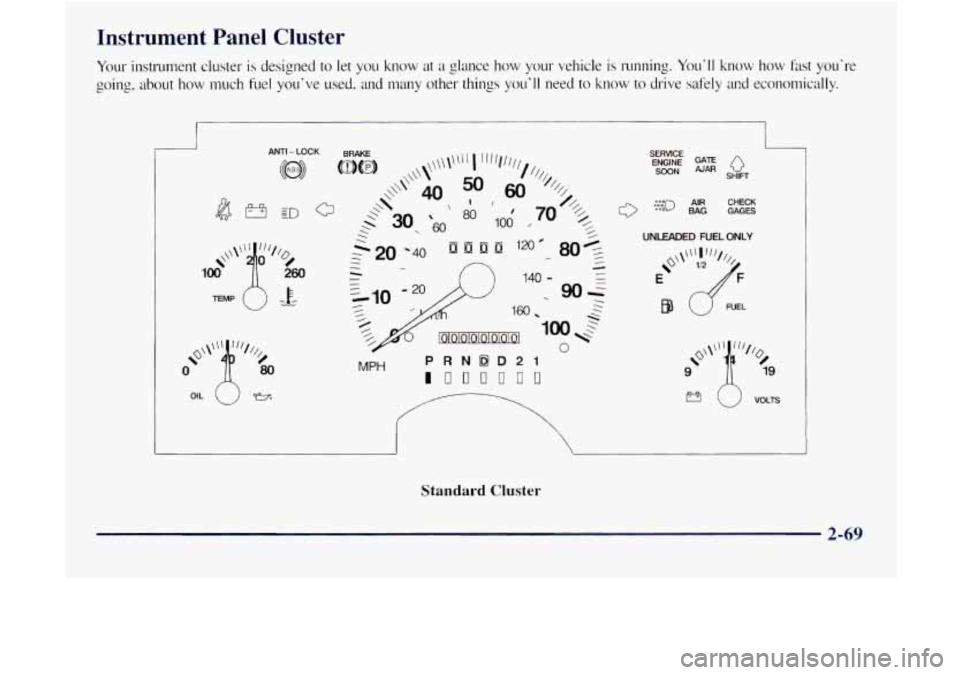
Instrument Panel Cluster
Your instrument cluster is designed to let you know at a glance how your vehicle is running. You'll know how fast you're
going. about how much fuel you've used. and many other things you'll need to know to drive safely at?d economically.
ANTI - LOCK
OIL (J y3
MPH
SERVlCE GATE ENGINE pJAR SOON Q SHIFT
0
{;;--J AIR CHECK BAG GAGES
UNLEADED FUEL ONLY
!3 i) VOLTS
Standard Cluster
2-69
Page 131 of 410
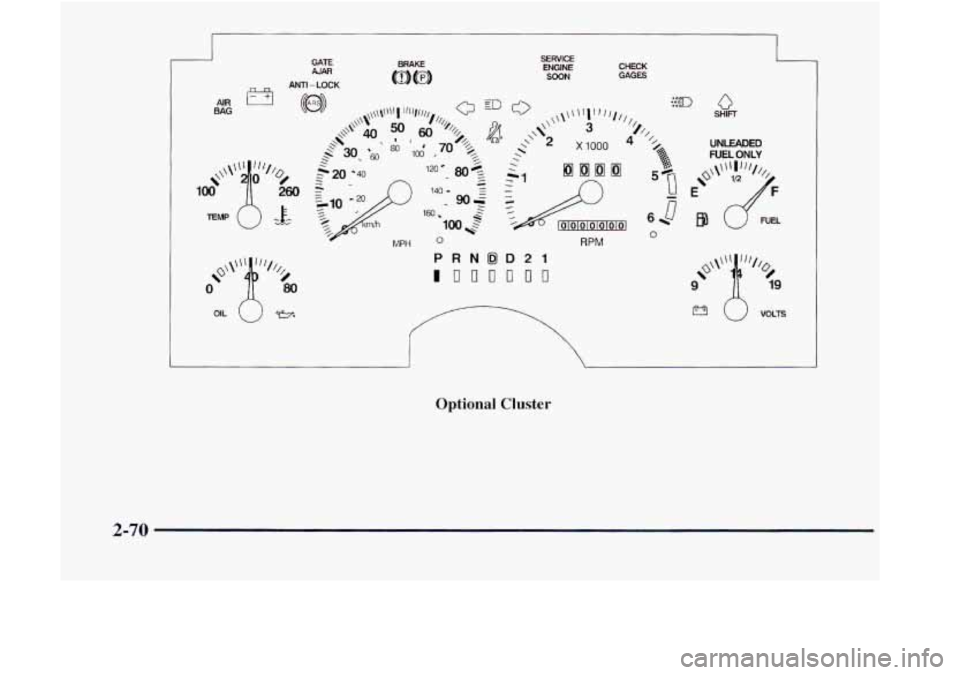
BAG AIR PI
GATE AJAR
ANTI -LOCK
SERVICE ENGINE SOON CHECK
GAGES
.e0 .oo .J 30 SHIFT
n
MPH
PRNDD21
111[101100
Optional Cluster
n
UNLEADED FUEL ONLY
RPM W
2-70